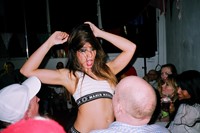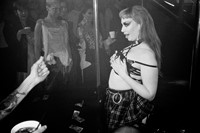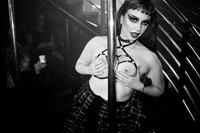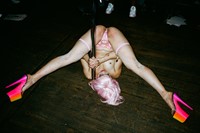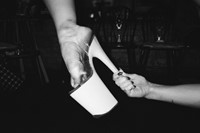Despite being an age-old industry, the image of a strip club has remained fixed in the cultural imagination for decades: a dark room with a lot of plush red furniture; groups of men in suits being served short drinks by women in six-inch heels; a metal pole glinting in the rotating light of a disco ball; a sign on the outside that probably features the word “gentleman”. In some cases that might actually be what you find, but the people who work in these sequestered and mysterious places are often as obscured as the blacked-out windows on the outside.
If you’ve ever wanted to be a fly on the wall of a strip club changing room, Wanting You To Want Me: Stories From the Secret World of Strip Clubs is as close as you’re likely to get without actually being employed there. Put together by Dazed art writer Emily Dinsdale and photographer Bronwen Parker-Rhodes, this book illuminates the magic and the mundanity of London’s strip clubs from an insider’s perspective, challenging cliches and providing a direct line to the heart of the industry: the dancers themselves.
Candid images capture women in their quiet moments, applying lipstick in a changing room mirror surrounded by bags of walnut halves and bottles of red wine, while first-person tales touch on everything from regular customers and personal relationships to body image and beauty. It’s a candid and often conflicting account of a world that’s as complex as it is unique, and brings some much-needed warmth and humour to the table at a time when cities around the UK are banning strip clubs and putting the livelihoods of sex workers at risk.
We spoke to Dinsdale and Parker-Rhodes about challenging the stereotypes associated with strip clubs, celebrating the camaraderie between the women that work in them, and the future of sexual entertainment venues in the UK.
Emma Garland: The book is such a warm and intimate look into what happens behind the doors of strip clubs in the UK. Congratulations! What was the initial spark that made you want to put something like this together?
Bronwen Parker-Rhodes: Long before I met Emily, I had been trying for some time to make a documentary about my experiences as a stripper and the incredible women I worked with, but I kept coming up against problems. Many of the really interesting women with really valuable stories would never appear on camera – but they would agree to do anonymous voice interviews. So I soon realised that the only way I could tell these wonderful stories would be by transcribing these women’s words and turning them into a book. When I met Emily, she shared my same vision for capturing this fascinating, hilarious, beautiful world, so it just felt like a perfect fit.
ED: I think strip clubs are fascinating and kind of fell in love with the women I met and loads of aspects of the stripping world I encountered. Although stripping often involves a great deal of performance and artifice, there’s something about the atmosphere that encourages people to be confessional and allows for so many very candid conversations. I really wanted to get hold of that and preserve it in some tangible way.
I think we found the perfect collaborator in each other. The book is a labour of love, really. We both knew it was going to be a subjective, insider’s account – kind of an oral history – rather than a clinical, detached investigation, but we felt like if we presented lots of perspectives it could create a nuanced picture. We tried to tread lightly and not impose ourselves too much, or to shoe-horn the stories to fit a preexisting idea of strip clubs.
EG: There’s a lot of curiosity about strip clubs, but probably most people have a stereotype or an idea in their head that they’re looking to have confirmed rather than challenged. I’d say this book does a bit of both in the stories it tells, but one thing you definitely can’t ignore is the fact that the strippers are real people with interior lives and agency and incredible personalities. When you were arranging interviews, what were the main questions you felt would be most interesting to ask?
ED: The women we met dancing are so incredibly funny and courageous and they have this amazing ingenuity. There’s definitely a caricature stripper-ness that some of the women tap into, almost as a power source. But you also encounter a lot in the book that doesn’t evince those typical ideas of how strippers are often portrayed.
We did have questions we used as prompts, but generally we only needed to refer to them occasionally because the conversations took their own course and had their own momentum. Bronwen and I both conducted interviews and we agreed in advance that we would never ask ‘Why did you become a stripper?’ or any questions that might make the women we spoke to feel like they had to justify their decision. Sometimes, women did want to speak about how they got into dancing but that was very much because they themselves steered the conversation in that direction, or the stories they wanted to share encompassed that part of their lives.
BPR: We felt very strongly that we didn’t want to ask the same tired questions that we, as strippers, are so often asked. We wanted to focus the stories on experiences within the club rather than make the women feel like they needed to justify their reasons for dancing. We wanted the reader to feel as if they were seated beside these women in the club changing room as they got ready for a shift, to feel included in their intimate conversations.
EG: Some of the photos catch the dancers mid-performance but the vast majority are taken in private moments: in the changing room, in their personal bedrooms, talking to each other. They have this very fly-on-the-wall feeling that sort of reinforces the reader as just that: a fly on the wall in these women’s lives. When you were thinking about the imagery for the book, what sort of feelings did you want to convey?
BPR: I have worked in strip clubs on and off for the past 20 years, and have been photographing my friends throughout that time. I was never really thinking about where these images would end up, I just wanted to capture this fascinating world for myself. Like the interviews in the book, the photography is attempting to show the raw unfiltered beauty of stripping. I’ve never wanted to glamourise it, because for me, it’s the gritty honesty of this world that I initially fell in love with when I first stepped foot in a strip club aged 18.
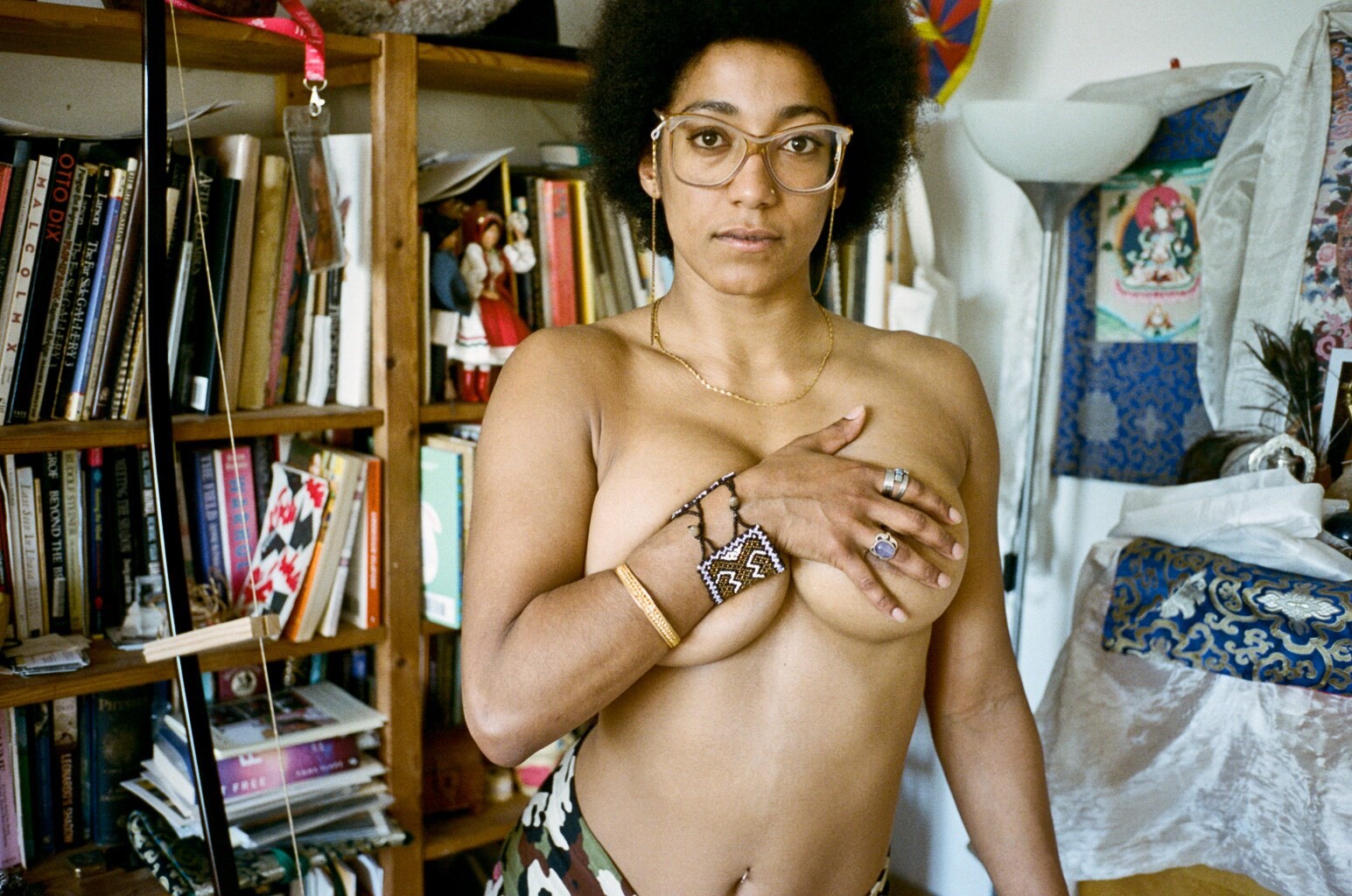
“The changing rooms really are a magic space. I feel like being in such close quarters with such a variety of women from different backgrounds – and then removing all your clothes – creates an honesty and openness. The conversations that happen there are so unfiltered and hilarious, it’s really refreshing“ – Bronwen Parker-Rhodes
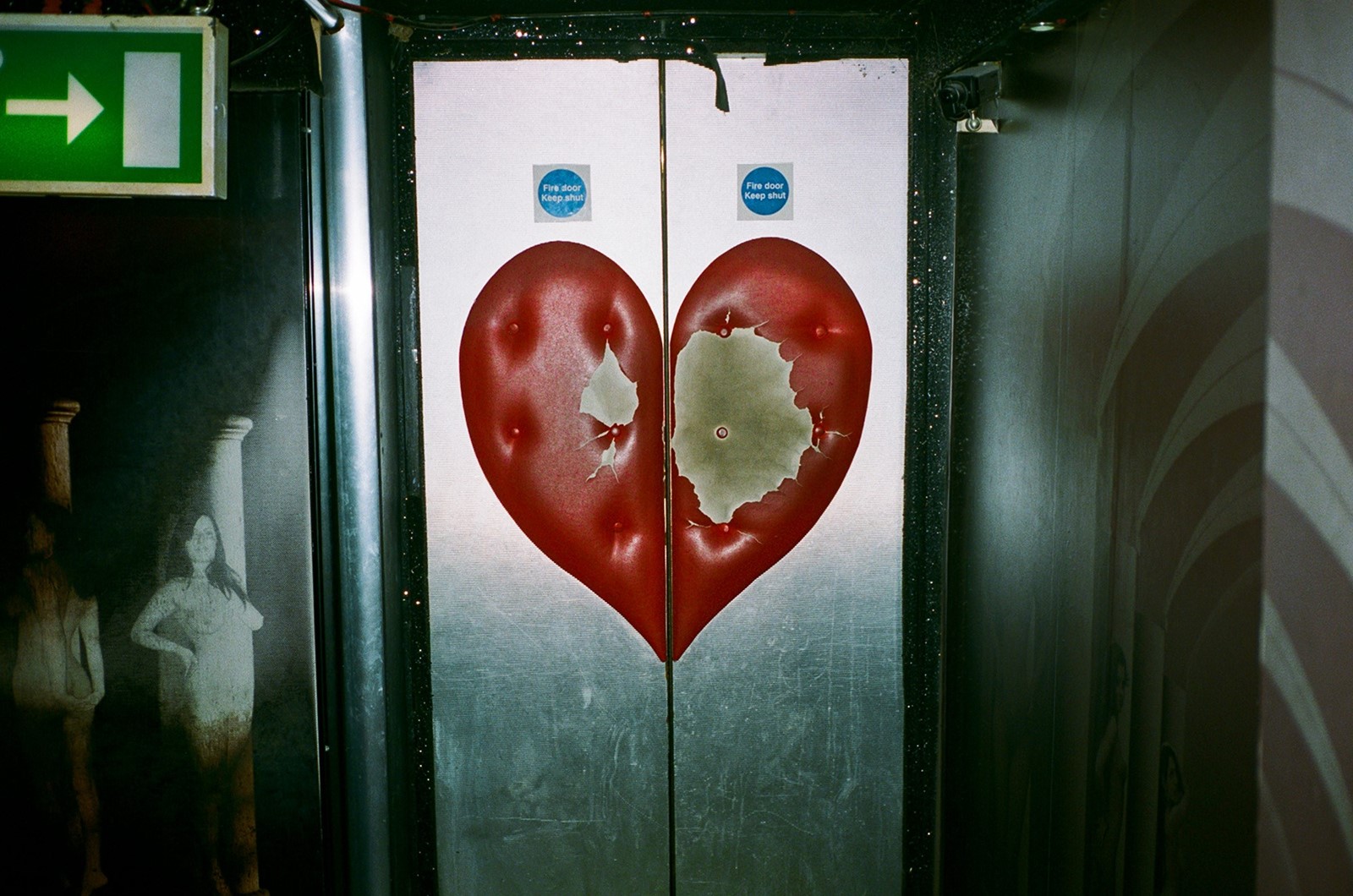
EG: The book definitely captures the mundanity of the job as well as its peculiarities. In a lot of the photos you can see, like, an open bag of walnuts on the table in the dressing room, or maybe someone’s just sorting through their underwear. It captures women in their quiet personal moments, as well as their goddess positions on stage. When you think back to your own time in strip clubs, what are the things that immediately come to mind – is it the everyday stuff like chatting in the dressing room and plucking ingrown hairs, or the more unique moments that happen on the floor?
BPR: The changing rooms really are a magic space. I feel like being in such close quarters with such a variety of women from different backgrounds – and then removing all your clothes – creates an honesty and openness. The conversations that happen there are so unfiltered and hilarious, it’s really refreshing.
I also think that there’s a comforting ritual and routine to the changing room. I always used to arrive at work an hour early so I could really enjoy the transformation process from Bronwen to ‘Honey’. The anticipation and excitement of a lucrative night, making sure every inch of yourself is immaculate and enticing. I also find it surprising that after so many years of doing this job, I would still get a flutter of exhilarating butterflies every time I stepped on stage. It’s an addictive feeling.
ED: My memories are a strange montage of all those things … the mundane elements, the gross detritus in the changing rooms, the odd, deathly quiet daytime shifts. But, as Bronwen said, the remarkable conversations where you’re drawing on this whole lexicon of very specific shared experience and it’s so funny. Also, the sensation of dancing on stage which was sometimes so exhilarating, like channelling something really thrilling and uninhibited ... as if you’re dancing in your bedroom to your favourite songs, except you have an audience and they become extras in this elaborate fantasy of yourself you’re enacting on stage.
EG: There’s an equal measure of reminiscing and complaining about venues in the book, particularly when it comes to diversity of appearance and camaraderie. Some dancers recall working in clubs in the 2000s that had a super broad range of body types, while others say that the introduction of VIP experiences has divided the workers more. There's a sense of loss, in places. What’s the biggest change you’ve seen in strip clubs over the last ten to 20 years?
BPR: For me, the biggest change was the introduction of private dancing. When I first started, it was purely stage shows and you had very limited contact with customers. I used to go to work with an enormous trolley suitcase of costumes because I had to wear a completely different outfit for each stage show I performed. When clubs started installing private dancing booths, suddenly the emphasis shifted to the hustle. You couldn’t rely on men throwing money at you on stage, now you had to convince them to take you for a private dance.
EG: Strip clubs are under increasing threat in the UK, with cities like Bristol and Edinburgh voting to ban them – and of course London has its own storied history with sexual entertainment venues too, with councils either capping them or many clubs simply falling to gentrification. Do you think people's attitudes to strip clubs have changed in the last ten to 20 years?
ED: Pole dancing has become much more mainstream in some ways and I’ve always found that most people are deeply interested rather than shocked if you say you used to be a dancer, they want to ask a million questions. But I’m not sure if that’s symptomatic of sex work becoming more accepted or if it’s of people becoming more prurient. In a way, it’s hard for me to step back and take an overview of the wider perception of strip clubs because I basically went from being a part of that world to working in the creative industries, where I’ve never felt that having been a stripper has negatively affected me so I’ve rarely had to encounter that kind of prejudice. I feel like I’ve been insulated from it to some extent.
In east London, which historically has been this sort of cash-in-hand counterpoint to the City – the legitimate centre of commerce – there was a constellation of sexual entertainment venues that have begun to disappear. They’re under the threat of erasure because of gentrification, real estate prices, licensing regulations etc. And there was what felt like a big attempt to ‘clean up‘ the East End in the run-up to the 2012 Olympics. They do feel a bit like endangered spaces, but then I’m also conscious of not wanting myself to lapse into being overly romantic or being drawn into a nostalgic kind of story about the industry. Within, there’s often so much talk among strippers of ‘it used to be better’, as the halcyon days of stripping are perpetually over the hill, regardless of when you started or how long you’ve been dancing.
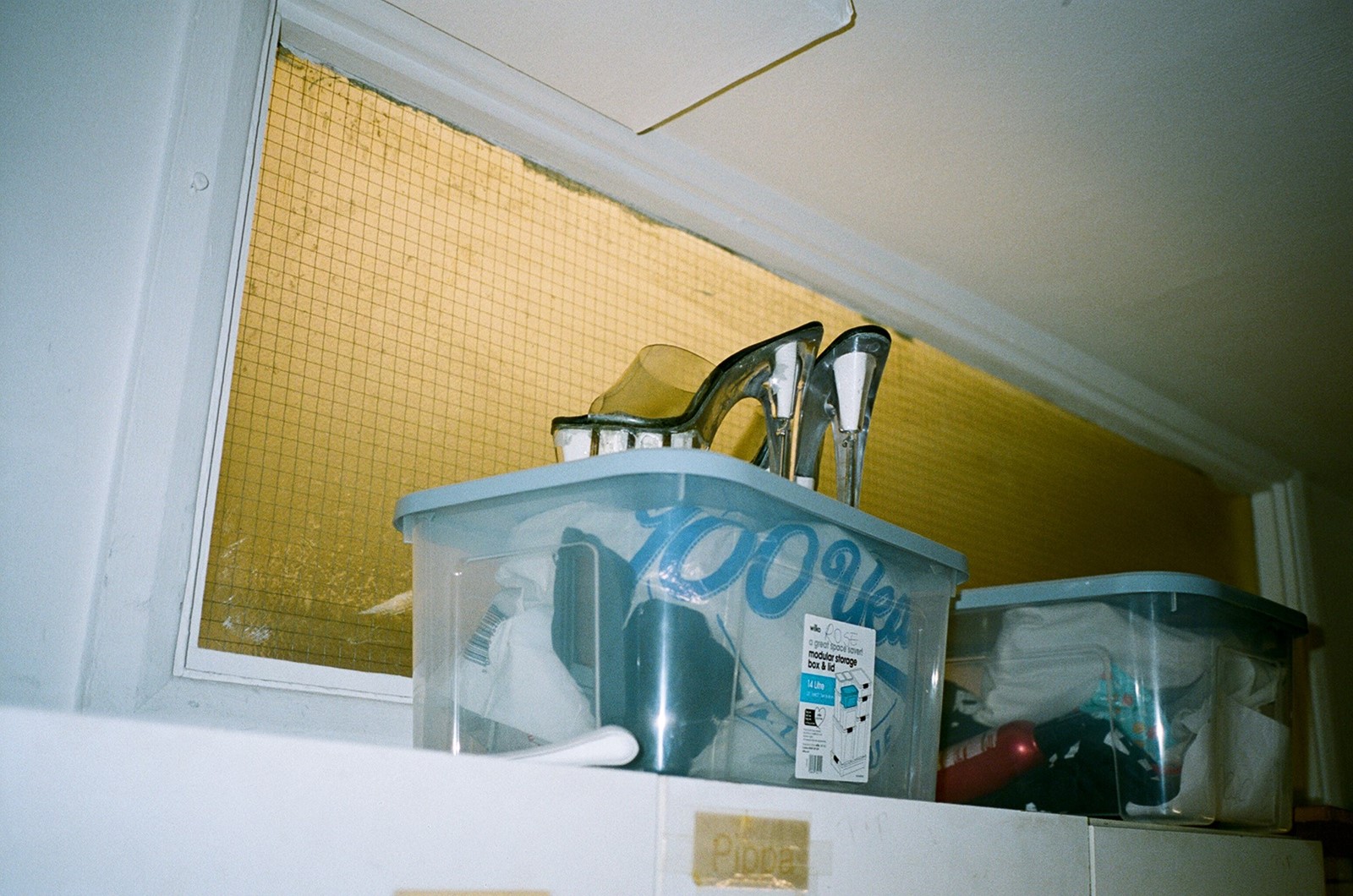
“We want readers to feel drawn into the stories like they would be drawn into compelling conversations as if they were sitting in a darkened booth or side by side in the changing rooms. I hope there are moments of empathy and recognition between the dancers narrating these stories and the readers – whoever they might be and whether or not they’ve ever set foot inside a strip club” – Emily Dinsdale
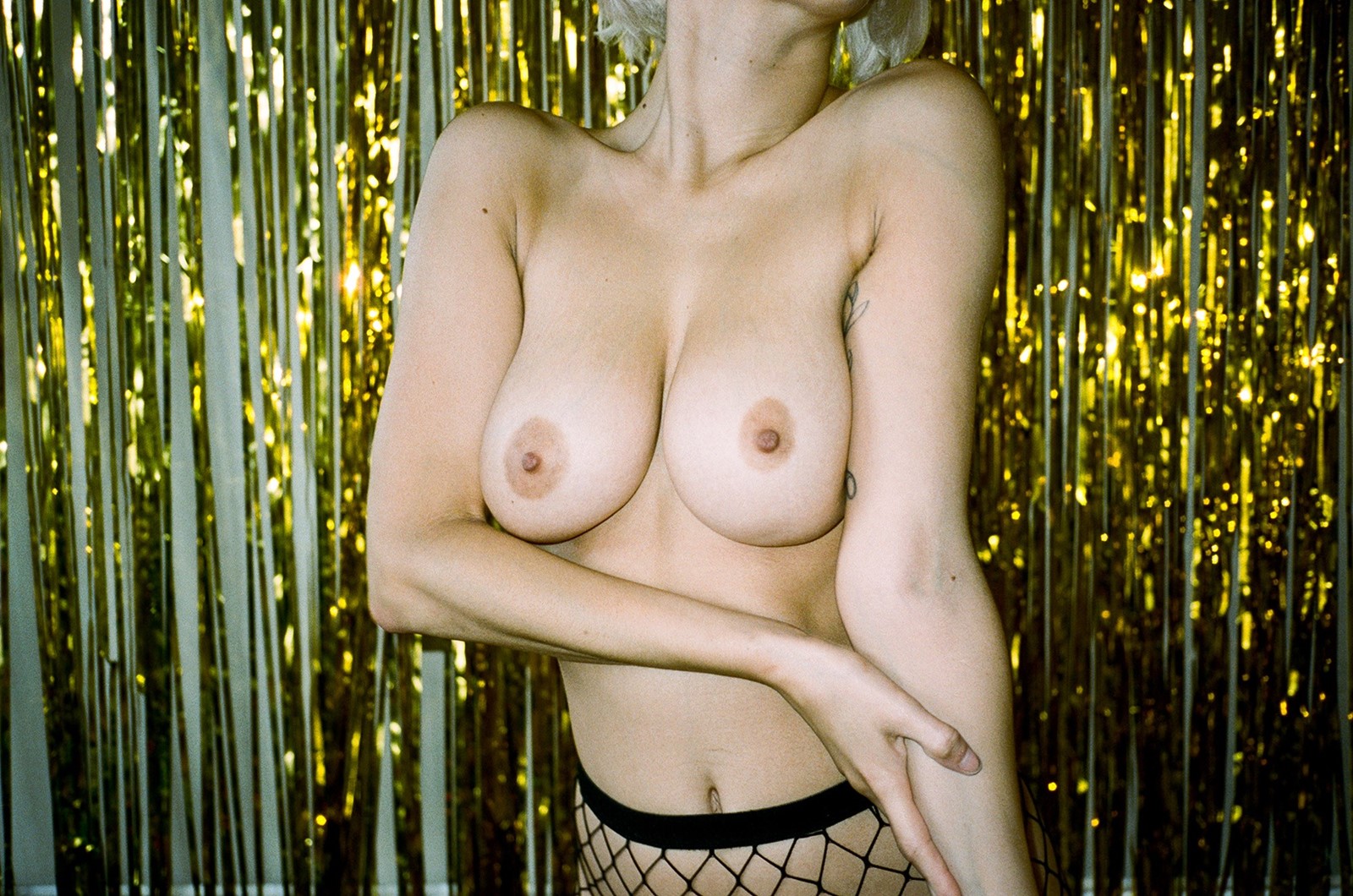
EG: Do you think the role of strip clubs in society is changing?
ED: I think the role of strip clubs has always been more all-encompassing than people might imagine, in terms of what customers walk into strip clubs seeking – affirmation, company, intrigue, escapism, confession, entertainment, healing, so many things. I do think, as society changes, what strip clubs represent inevitably changes but it’s so massively complex. Discussions about strip clubs raise so many different questions and we’re not claiming to have arrived at definitive answers to so many aspects of what we’ve encountered.
EG: At the same time, we’re also seeing new kinds of approaches to stripping, like Harpies – the first LGBTQ+ strip club in Europe, which operates as an event hosted inside another strip club. So it’s like a lot of censorship and a bit of progression happening simultaneously. What do you think the future of strip clubs in the UK looks like?
BPR: I’ve noticed a real change in the attitude towards stripping over the past 20 years – it feels like there’s slowly becoming more acceptance and openness around it. Regarding the future of stripping, Covid had a massive impact and I personally know many strippers who were suddenly forced to find other ways to make an income, and will probably never return to it.
ED: I think new clubs and club nights like Harpies are the way forward. There’s one story in the book in particular where a dancer describes a customer coming into the club for a queer experience and because it’s a space they feel able to have a frank conversation about their complex sexual identity but also, in my experience, strip clubs here in London can often feel like very binary spaces in terms of gender. They’re such a complicated mix ... in some ways, they are a kind of paradigm of what’s going on in the world at large, and in other ways, they’re insulated from outside influences and they feel resistant to change, somehow ... they’re worlds within worlds. So I think more spaces like Harpies need to open.
My experience is quite limited to London. For instance, visiting Jumbo’s Clown Room in LA ... it felt very joyful and theatrical. The clientele was really mixed, there were tons of women in the audience. I think that would be a great direction for strip clubs here.
EG: One dancer talks about the political climate around sex work in the post-#MeToo world, saying that women’s rights have become much more of a mainstream talking point but – and I’m paraphrasing slightly – ‘in reality, it’s women’s rights for good women but not the sluts‘. The book doesn’t focus too much on that at all, but were those divisions in the back of your mind at all while putting it together?
ED: That was something we were definitely very conscious of and interested in. There are moments in the book where women describe feeling like their voices and opinions are negated because they are strippers, as if they’ve somehow relinquished the right to be respected. I think it’s really interesting the ways in which different species of feminism collide with responses to strip clubs and how those things sit side-by-side and interact. Some ideas of feminism – arguably more regressive feminist ideologies – can’t accommodate sex work as valid.
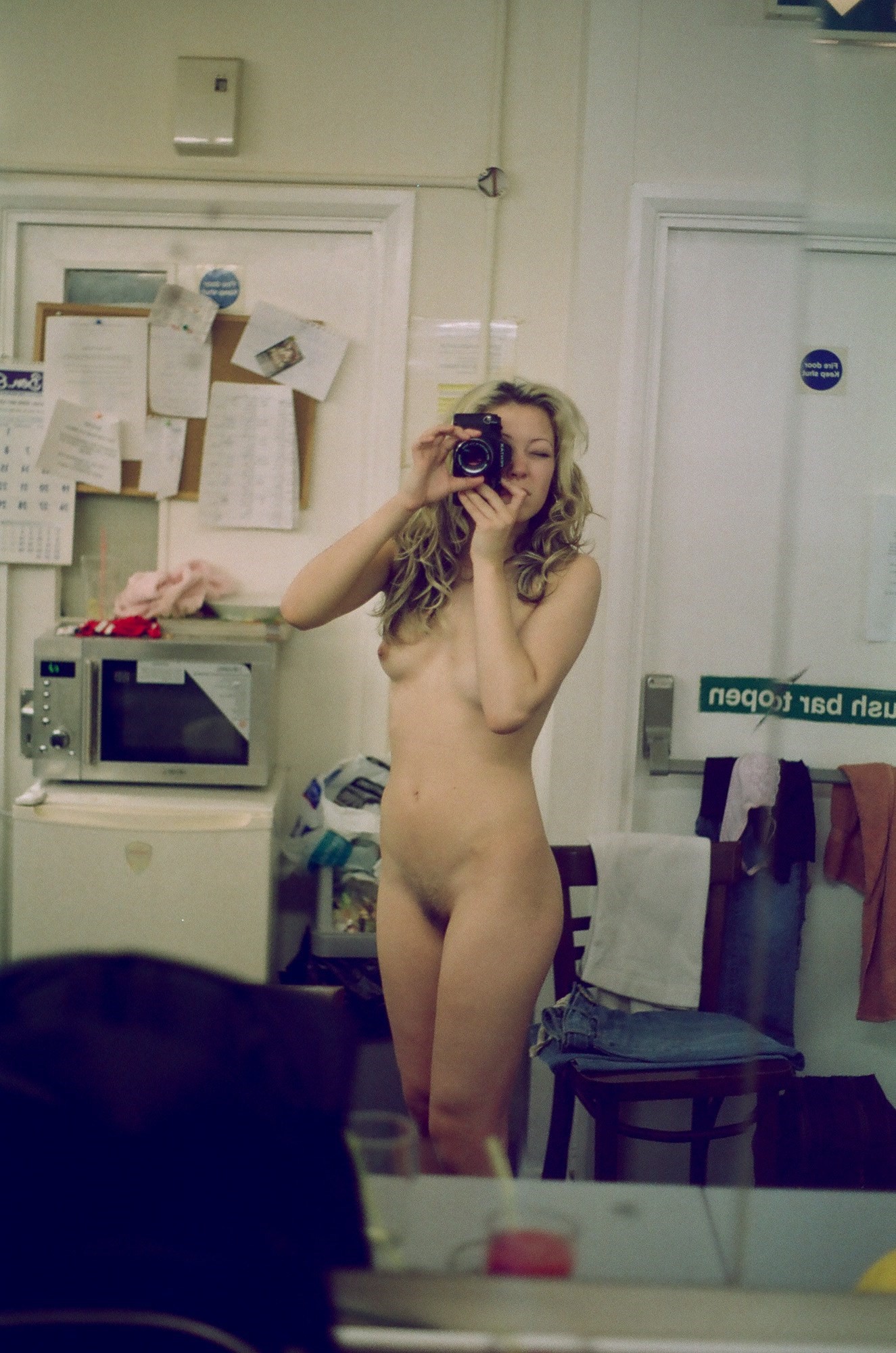
EG: The final word comes from a dancer called Chiqui who talks about the magic that gets created when women come together in the way they do in a strip club. It‘s a very beautiful and powerful note to end on. Would you say that sentiment summarises the whole ethos behind the book for you?
BPR: I love Chiqui, she’s such a force of nature. She was one of the last interviews I conducted for the book and I vividly remember her describing stripping as being like witchcraft, and thinking – that’s it!
It’s a complicated, messy world, and not all my experiences as a stripper have been positive, but ultimately, I am so proud to be part of this community because of the incredible friends I’ve made.
ED: I love how Chiqui describes the potency of women coming together in an environment where they are able to feel very uncensored in lots of ways. It is very powerful. That was how Bronwen and I felt and it was one of the phenomena that lots of other women we spoke to also described. Not to say there isn’t ever enmity, but it’s like an incredibly intense bonding exercise. One dancer, Amélie, talks about how everything is so heightened, and ‘if you get on with someone you really get on with them, and if you don’t get on with someone, you really don’t get on with them.‘ In our personal experience, there’s more camaraderie than there is hostility.
EG: What do you hope that people reading this book, regardless of how much they knew about sex work beforehand, will come away feeling?
ED: This morning, a former dancer friend I hadn’t seen for years messaged me saying, ‘Just finished your book. The whole thing was really emotional and the ending was beautiful. It made me miss those days with real physical longing.‘ That was so emotional for me to hear, it’s exactly what was at the heart of mine and Bronwen’s intentions for this book.
We want readers to feel drawn into the stories like they would be drawn into compelling conversations as if they were sitting in a darkened booth or side by side in the changing rooms. I hope there are moments of empathy and recognition between the dancers narrating these stories and the readers – whoever they might be and whether or not they’ve ever set foot inside a strip club. The tales touch upon so many experiences of shame, sexuality, labour, friendship, love, desire, ideas of beauty, objectification, gender etc. I hope they convey the multiplicity and complexity of the world they’re describing but also speak of the world outside the black-out strip club windows.
BPR: There isn’t one narrative or overarching experience to being a stripper. It’s a world full of diverse, conflicting stories and that’s the beauty of it. I think the reader can come away with all manner of feelings about what they’ve read, and that’s the point. But I will also add that this book is ultimately about real human connections, and that will resonate with everyone, regardless of any preexisting knowledge of the stripping community.
Wanting You to Want Me: Stories from the Secret World of Strip Clubs by Bronwen Parker-Rhodes and Emily Dinsdale is published by Hardie Grant Books, and is out now.

